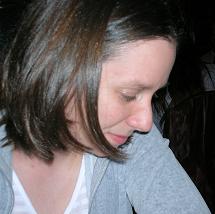Wednesday, March 05, 2008
Journey to Myself, ed. Julia Landau
 Sarah picked this up at the District Six Museum in Cape Town and lent it to me because of its similarity to the writing project we're working on. (I can say that without guilt because I actually did some writing this afternoon!) It's a collection of personal essays and poetry written by women in prison in South Africa. It's interesting, because Sarah and I toyed with the idea of doing writing workshops or compiling pieces written by the women we talked with. We decided against that idea, and while it was fascinating to read this, I'm glad we decided to do our writing differently.
Sarah picked this up at the District Six Museum in Cape Town and lent it to me because of its similarity to the writing project we're working on. (I can say that without guilt because I actually did some writing this afternoon!) It's a collection of personal essays and poetry written by women in prison in South Africa. It's interesting, because Sarah and I toyed with the idea of doing writing workshops or compiling pieces written by the women we talked with. We decided against that idea, and while it was fascinating to read this, I'm glad we decided to do our writing differently.Autobiographical narratives are tricky. In the preface to Journey to Myself, the editor notes that it's often difficult to separate fact from fiction in the stories these women tell. This is something Sarah and I certainly encountered as we interviewed various women for our project. We had to tackle racial, cultural, and language barriers. Some of our interviews were conducted through interpreters, which added another bias and another level of mediation to the perspective we received. Having women put their own stories down on paper seems less mediated, but the perspective is about as biased as they come. The author can be completely truthful, but it's easy to tell the truth while concealing certain parts and overemphasizing others. These authors especially had a vested interest in how they presented themselves. These stories were interesting for exactly this reason--it was often clear that pieces had been left out, and I wanted more. I wanted to delve more deeply into motivations and history and who these women really were, to find out why they had presented themselves in the ways they did.
While not as satisfying on a literary level, I found this collection fascinating. Partly for personal reasons, as it prompted a lot of thought for me on how I'm approaching telling the stories I collected last year. But also because I'm always interested in first person narratives and in figuring out the speaker--why did they choose to tell what they did? What did they leave out, and why?
As Sarah and I navigated truthfulness with one woman in particular this year, someone suggested it was just as important to hear the story she wanted to tell--the version of herself she wanted to believe--as it was to know what really happened. I was reminded of that comment as I wondered about the women whose writings appear in this collection. The title of the book reflects that idea--the writing of a personal story is a journey to the self, and whether the writing portrays a factual or imagined self, or a mixture of the two, all of these portrayals are significant in reaching a fuller understanding of the whole person.
This ended up being more about me and this writing project than the book I'm discussing. But somehow that seems fitting.
Labels: book review, reading
| posted by Barbara | 9:07 AM
